engine CADILLAC ESCALADE 2010 3.G Owner's Manual
[x] Cancel search | Manufacturer: CADILLAC, Model Year: 2010, Model line: ESCALADE, Model: CADILLAC ESCALADE 2010 3.GPages: 616, PDF Size: 39.41 MB
Page 155 of 616

Engine Coolant Heater
The engine coolant heater can provide easier startingand better fuel economy during engine warm-up in coldweather conditions at or below!18°C (0°F). Vehicleswith an engine heater should be plugged in at leastfour hours before starting. An internal thermostat inthe plug-end of the cord may exist which will preventengine coolant heater operation at temperaturesabove!18°C (0°F).
To Use the Engine Coolant Heater
1. Turn off the engine.
2. Open the hood and unwrap the electrical cord.The cord is secured to the Engine CompartmentFuse Block with a clip. Carefully remove the wiretie which secures the electrical cord. Do not cut theelectrical cord.
3. Plug the cord into a normal, grounded 110-voltAC outlet.
{WARNING:
Plugging the cord into an ungrounded outlet could
cause an electrical shock. Also, the wrong kind of
extension cord could overheat and cause a fire.
You could be seriously injured. Plug the cord into
a properly grounded three-prong 110-volt AC
outlet. If the cord will not reach, use a heavy-duty
three-prong extension cord rated for at least
15 amps.
4. Before starting the engine, be sure to unplug andstore the cord as it was before to keep it away frommoving engine parts. If you do not, it could bedamaged.
The length of time the heater should remain plugged independs on several factors. Ask a dealer/retailer in thearea where you will be parking the vehicle for the bestadvice on this.
3-31
Page 156 of 616
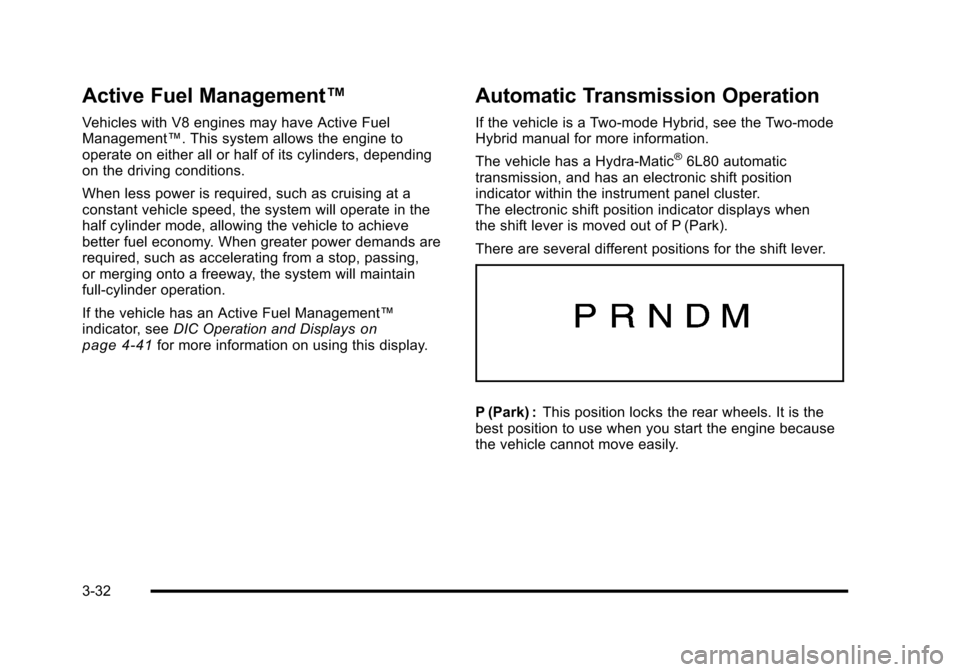
Active Fuel Management™
Vehicles with V8 engines may have Active FuelManagement™. This system allows the engine tooperate on either all or half of its cylinders, dependingon the driving conditions.
When less power is required, such as cruising at aconstant vehicle speed, the system will operate in thehalf cylinder mode, allowing the vehicle to achievebetter fuel economy. When greater power demands arerequired, such as accelerating from a stop, passing,or merging onto a freeway, the system will maintainfull-cylinder operation.
If the vehicle has an Active Fuel Management™indicator, seeDIC Operation and Displaysonpage 4!41for more information on using this display.
Automatic Transmission Operation
If the vehicle is a Two-mode Hybrid, see the Two-modeHybrid manual for more information.
The vehicle has a Hydra-Matic®6L80 automatictransmission, and has an electronic shift positionindicator within the instrument panel cluster.The electronic shift position indicator displays whenthe shift lever is moved out of P (Park).
There are several different positions for the shift lever.
P (Park) :This position locks the rear wheels. It is thebest position to use when you start the engine becausethe vehicle cannot move easily.
3-32
Page 157 of 616
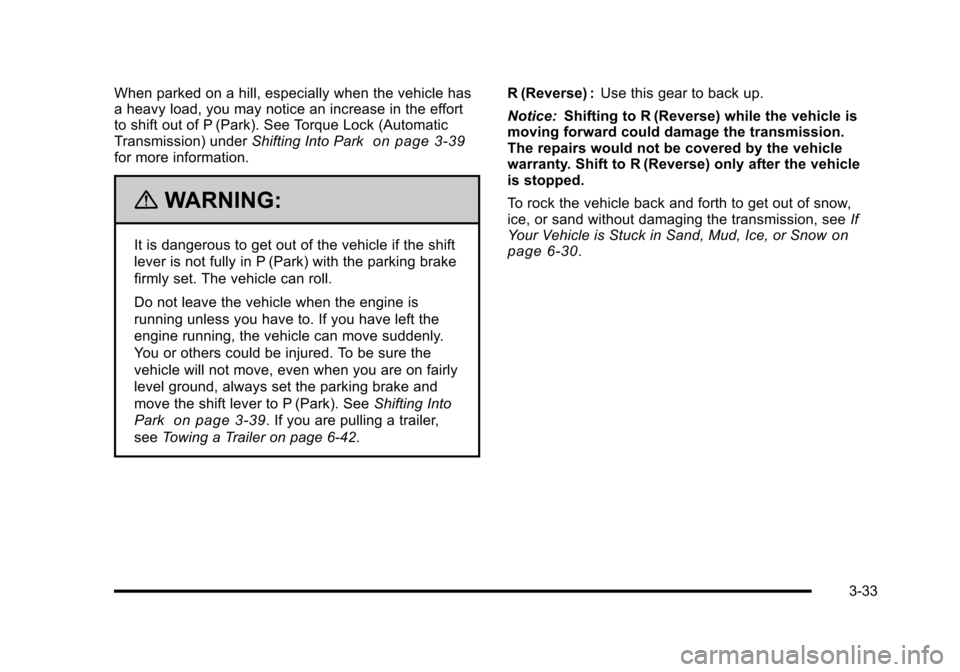
When parked on a hill, especially when the vehicle hasa heavy load, you may notice an increase in the effortto shift out of P (Park). See Torque Lock (AutomaticTransmission) underShifting Into Parkon page 3!39for more information.
{WARNING:
It is dangerous to get out of the vehicle if the shift
lever is not fully in P (Park) with the parking brake
firmly set. The vehicle can roll.
Do not leave the vehicle when the engine is
running unless you have to. If you have left the
engine running, the vehicle can move suddenly.
You or others could be injured. To be sure the
vehicle will not move, even when you are on fairly
level ground, always set the parking brake and
move the shift lever to P (Park). SeeShifting Into
Parkon page 3!39. If you are pulling a trailer,
seeTowing a Trailer on page 6!42.
R (Reverse) :Use this gear to back up.
Notice:Shifting to R (Reverse) while the vehicle ismoving forward could damage the transmission.The repairs would not be covered by the vehiclewarranty. Shift to R (Reverse) only after the vehicleis stopped.
To rock the vehicle back and forth to get out of snow,ice, or sand without damaging the transmission, seeIfYour Vehicle is Stuck in Sand, Mud, Ice, or Snowonpage 6!30.
3-33
Page 158 of 616

N (Neutral) :In this position, the engine does notconnect with the wheels. To restart when you arealready moving, use N (Neutral) only. Also, useN (Neutral) when the vehicle is being towed.
{WARNING:
Shifting into a drive gear while the engine is
running at high speed is dangerous. Unless your
foot is firmly on the brake pedal, the vehicle could
move very rapidly. You could lose control and hit
people or objects. Do not shift into a drive gear
while the engine is running at high speed.
Notice:Shifting out of P (Park) or N (Neutral) withthe engine running at high speed may damage thetransmission. The repairs would not be covered bythe vehicle warranty. Be sure the engine is notrunning at high speed when shifting the vehicle.
D (Drive) :This position is for normal driving. It providesthe best fuel economy. If you need more power forpassing, and you are:
.Going less than about 35 mph (55 km/h), push theaccelerator pedal about halfway down.
.Going about 35 mph (55 km/h) or more, push theaccelerator all the way down.
By doing this, the vehicle shifts down to the next gearand has more power.
D (Drive) can be used when towing a trailer, carrying aheavy load, driving on steep hills, or for off-road driving.You may want to shift the transmission to a lower gearselection if the transmission shifts too often.
Downshifting the transmission in slippery roadconditions could result in skidding, see Skidding underLoss of Control on page 6!12.
M (Manual Mode) :This position lets drivers selectthe range of gears appropriate for current drivingconditions. See Driver Shift Control (DSC) later inthis section.
Notice:Spinning the tires or holding the vehicle inone place on a hill using only the accelerator pedalmay damage the transmission. The repair will not becovered by the vehicle warranty. If you are stuck, donot spin the tires. When stopping on a hill, use thebrakes to hold the vehicle in place.
The vehicle has a shift stabilization feature thatadjusts the transmission shifting to the currentdriving conditions in order to reduce rapid upshiftsand downshifts. This shift stabilization feature isdesigned to determine, before making an upshift, ifthe engine will be able to maintain vehicle speed by
3-34
Page 159 of 616
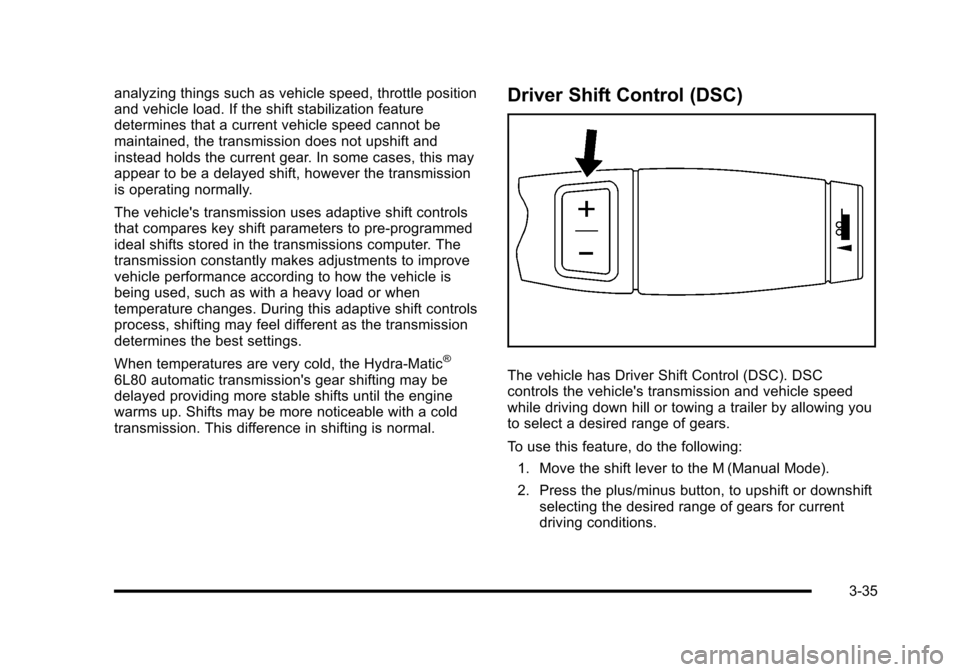
analyzing things such as vehicle speed, throttle positionand vehicle load. If the shift stabilization featuredetermines that a current vehicle speed cannot bemaintained, the transmission does not upshift andinstead holds the current gear. In some cases, this mayappear to be a delayed shift, however the transmissionis operating normally.
The vehicle's transmission uses adaptive shift controlsthat compares key shift parameters to pre-programmedideal shifts stored in the transmissions computer. Thetransmission constantly makes adjustments to improvevehicle performance according to how the vehicle isbeing used, such as with a heavy load or whentemperature changes. During this adaptive shift controlsprocess, shifting may feel different as the transmissiondetermines the best settings.
When temperatures are very cold, the Hydra-Matic®
6L80 automatic transmission's gear shifting may bedelayed providing more stable shifts until the enginewarms up. Shifts may be more noticeable with a coldtransmission. This difference in shifting is normal.
Driver Shift Control (DSC)
The vehicle has Driver Shift Control (DSC). DSCcontrols the vehicle's transmission and vehicle speedwhile driving down hill or towing a trailer by allowing youto select a desired range of gears.
To use this feature, do the following:
1. Move the shift lever to the M (Manual Mode).
2. Press the plus/minus button, to upshift or downshiftselecting the desired range of gears for currentdriving conditions.
3-35
Page 161 of 616
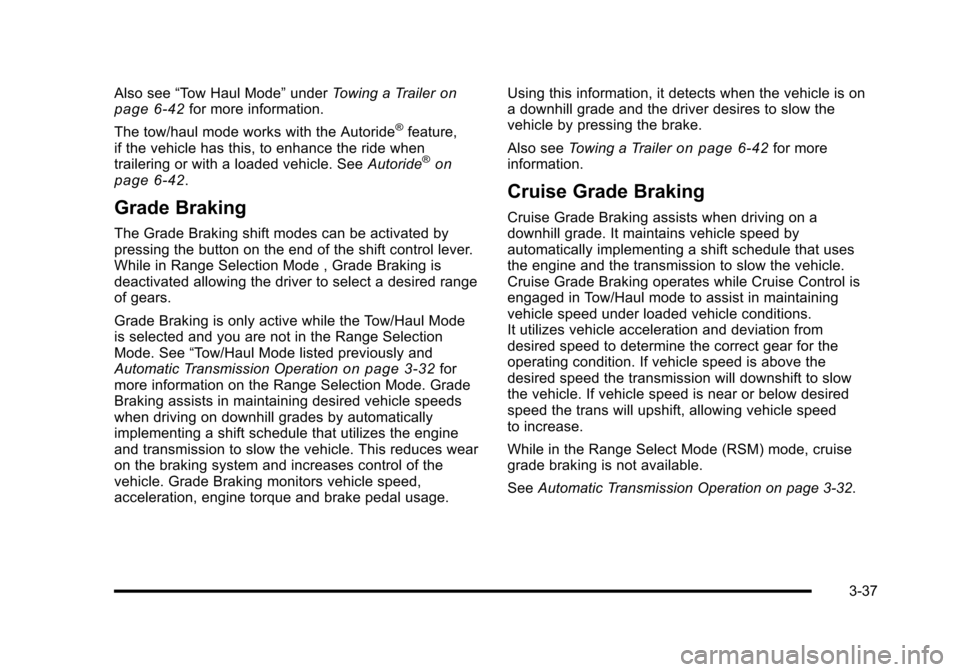
Also see“Tow Haul Mode”underTowing a Traileronpage 6!42for more information.
The tow/haul mode works with the Autoride®feature,if the vehicle has this, to enhance the ride whentrailering or with a loaded vehicle. SeeAutoride®onpage 6!42.
Grade Braking
The Grade Braking shift modes can be activated bypressing the button on the end of the shift control lever.While in Range Selection Mode , Grade Braking isdeactivated allowing the driver to select a desired rangeof gears.
Grade Braking is only active while the Tow/Haul Modeis selected and you are not in the Range SelectionMode. See“Tow/Haul Mode listed previously andAutomatic Transmission Operationon page 3!32formore information on the Range Selection Mode. GradeBraking assists in maintaining desired vehicle speedswhen driving on downhill grades by automaticallyimplementing a shift schedule that utilizes the engineand transmission to slow the vehicle. This reduces wearon the braking system and increases control of thevehicle. Grade Braking monitors vehicle speed,acceleration, engine torque and brake pedal usage.
Using this information, it detects when the vehicle is ona downhill grade and the driver desires to slow thevehicle by pressing the brake.
Also seeTowing a Traileron page 6!42for moreinformation.
Cruise Grade Braking
Cruise Grade Braking assists when driving on adownhill grade. It maintains vehicle speed byautomatically implementing a shift schedule that usesthe engine and the transmission to slow the vehicle.Cruise Grade Braking operates while Cruise Control isengaged in Tow/Haul mode to assist in maintainingvehicle speed under loaded vehicle conditions.It utilizes vehicle acceleration and deviation fromdesired speed to determine the correct gear for theoperating condition. If vehicle speed is above thedesired speed the transmission will downshift to slowthe vehicle. If vehicle speed is near or below desiredspeed the trans will upshift, allowing vehicle speedto increase.
While in the Range Select Mode (RSM) mode, cruisegrade braking is not available.
SeeAutomatic Transmission Operation on page 3!32.
3-37
Page 163 of 616
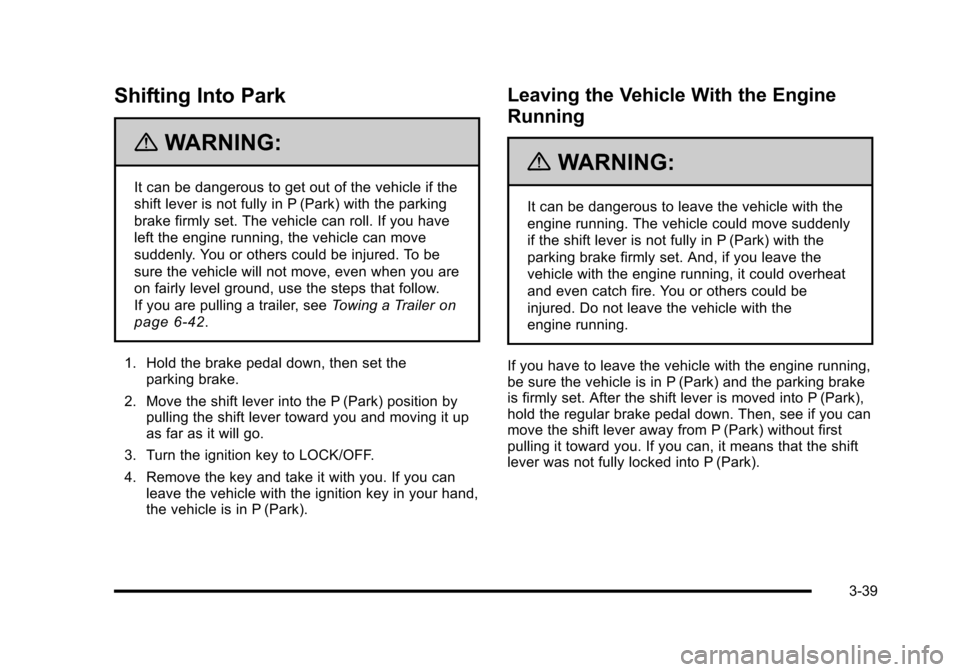
Shifting Into Park
{WARNING:
It can be dangerous to get out of the vehicle if the
shift lever is not fully in P (Park) with the parking
brake firmly set. The vehicle can roll. If you have
left the engine running, the vehicle can move
suddenly. You or others could be injured. To be
sure the vehicle will not move, even when you are
on fairly level ground, use the steps that follow.
If you are pulling a trailer, seeTowing a Traileron
page 6!42.
1. Hold the brake pedal down, then set theparking brake.
2. Move the shift lever into the P (Park) position bypulling the shift lever toward you and moving it upas far as it will go.
3. Turn the ignition key to LOCK/OFF.
4. Remove the key and take it with you. If you canleave the vehicle with the ignition key in your hand,the vehicle is in P (Park).
Leaving the Vehicle With the Engine
Running
{WARNING:
It can be dangerous to leave the vehicle with the
engine running. The vehicle could move suddenly
if the shift lever is not fully in P (Park) with the
parking brake firmly set. And, if you leave the
vehicle with the engine running, it could overheat
and even catch fire. You or others could be
injured. Do not leave the vehicle with the
engine running.
If you have to leave the vehicle with the engine running,be sure the vehicle is in P (Park) and the parking brakeis firmly set. After the shift lever is moved into P (Park),hold the regular brake pedal down. Then, see if you canmove the shift lever away from P (Park) without firstpulling it toward you. If you can, it means that the shiftlever was not fully locked into P (Park).
3-39
Page 165 of 616

Parking Over Things That Burn
{WARNING:
Things that can burn could touch hot exhaust
parts under the vehicle and ignite. Do not park
over papers, leaves, dry grass, or other things that
can burn.
Engine Exhaust
{WARNING:
Engine exhaust contains Carbon Monoxide (CO)
which cannot be seen or smelled. Exposure to CO
can cause unconsciousness and even death.
Exhaust may enter the vehicle if:
.The vehicle idles in areas with poor ventilation
(parking garages, tunnels, deep snow that
may block underbody airflow or tail pipes).
.The exhaust smells or sounds strange
or different.
(Continued)
WARNING: (Continued)
.The exhaust system leaks due to corrosion
or damage.
.The vehicle’s exhaust system has been
modified, damaged or improperly repaired.
.There are holes or openings in the vehicle
body from damage or after-market
modifications that are not completely sealed.
If unusual fumes are detected or if it is suspected
that exhaust is coming into the vehicle:
.Drive it only with the windows
completely down.
.Have the vehicle repaired immediately.
Never park the vehicle with the engine running in
an enclosed area such as a garage or a building
that has no fresh air ventilation.
3-41
Page 166 of 616
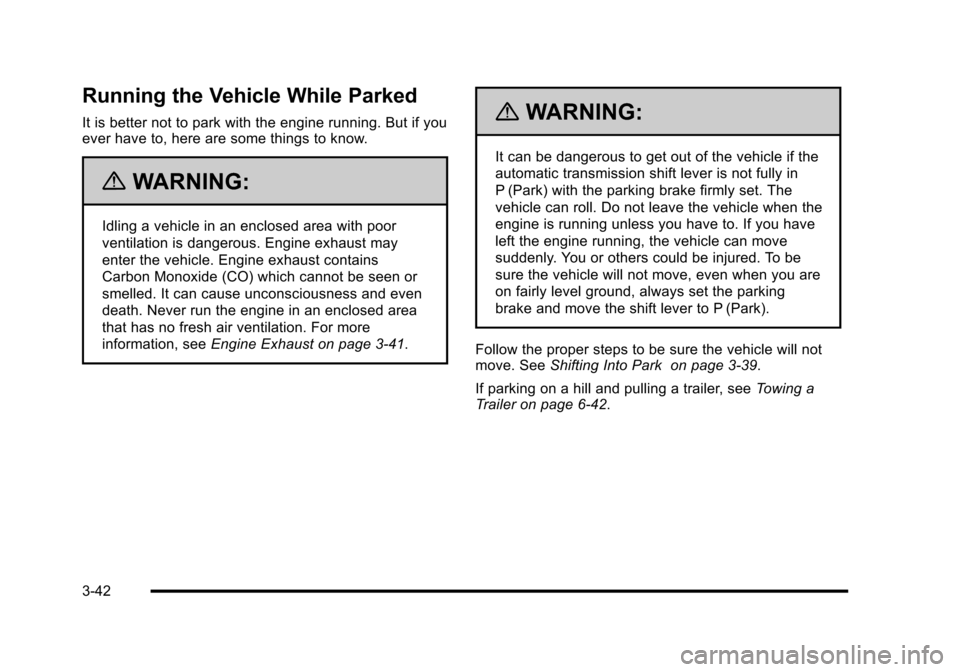
Running the Vehicle While Parked
It is better not to park with the engine running. But if youever have to, here are some things to know.
{WARNING:
Idling a vehicle in an enclosed area with poor
ventilation is dangerous. Engine exhaust may
enter the vehicle. Engine exhaust contains
Carbon Monoxide (CO) which cannot be seen or
smelled. It can cause unconsciousness and even
death. Never run the engine in an enclosed area
that has no fresh air ventilation. For more
information, seeEngine Exhaust on page 3!41.
{WARNING:
It can be dangerous to get out of the vehicle if the
automatic transmission shift lever is not fully in
P (Park) with the parking brake firmly set. The
vehicle can roll. Do not leave the vehicle when the
engine is running unless you have to. If you have
left the engine running, the vehicle can move
suddenly. You or others could be injured. To be
sure the vehicle will not move, even when you are
on fairly level ground, always set the parking
brake and move the shift lever to P (Park).
Follow the proper steps to be sure the vehicle will notmove. SeeShifting Into Park on page 3!39.
If parking on a hill and pulling a trailer, seeTowing aTrailer on page 6!42.
3-42
Page 194 of 616
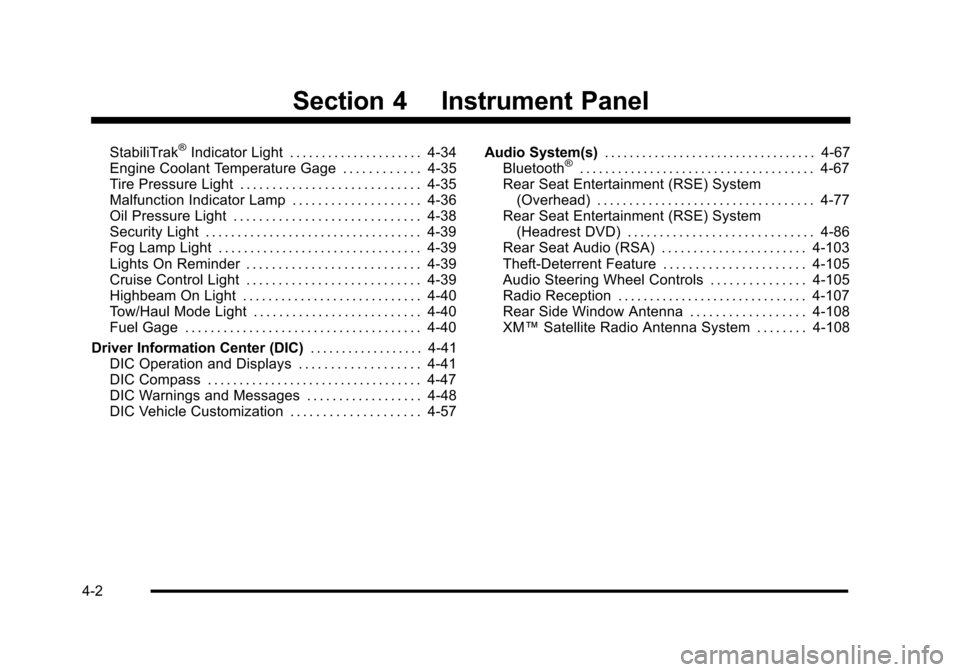
Section 4 Instrument Panel
StabiliTrak®Indicator Light . . . . . . . . . . . . . . . . . . . . . 4-34Engine Coolant Temperature Gage . . . . . . . . . . . . 4-35Tire Pressure Light . . . . . . . . . . . . . . . . . . . . . . . . . . . . 4-35Malfunction Indicator Lamp . . . . . . . . . . . . . . . . . . . . 4-36Oil Pressure Light . . . . . . . . . . . . . . . . . . . . . . . . . . . . . 4-38Security Light . . . . . . . . . . . . . . . . . . . . . . . . . . . . . . . . . . 4-39Fog Lamp Light . . . . . . . . . . . . . . . . . . . . . . . . . . . . . . . . 4-39Lights On Reminder . . . . . . . . . . . . . . . . . . . . . . . . . . . 4-39Cruise Control Light . . . . . . . . . . . . . . . . . . . . . . . . . . . 4-39Highbeam On Light . . . . . . . . . . . . . . . . . . . . . . . . . . . . 4-40Tow/Haul Mode Light . . . . . . . . . . . . . . . . . . . . . . . . . . 4-40Fuel Gage . . . . . . . . . . . . . . . . . . . . . . . . . . . . . . . . . . . . . 4-40
Driver Information Center (DIC). . . . . . . . . . . . . . . . . . 4-41DIC Operation and Displays . . . . . . . . . . . . . . . . . . . 4-41DIC Compass . . . . . . . . . . . . . . . . . . . . . . . . . . . . . . . . . . 4-47DIC Warnings and Messages . . . . . . . . . . . . . . . . . . 4-48DIC Vehicle Customization . . . . . . . . . . . . . . . . . . . . 4-57
Audio System(s). . . . . . . . . . . . . . . . . . . . . . . . . . . . . . . . . . 4-67Bluetooth®. . . . . . . . . . . . . . . . . . . . . . . . . . . . . . . . . . . . . 4-67Rear Seat Entertainment (RSE) System(Overhead) . . . . . . . . . . . . . . . . . . . . . . . . . . . . . . . . . . 4-77Rear Seat Entertainment (RSE) System(Headrest DVD) . . . . . . . . . . . . . . . . . . . . . . . . . . . . . 4-86Rear Seat Audio (RSA) . . . . . . . . . . . . . . . . . . . . . . . 4-103Theft-Deterrent Feature . . . . . . . . . . . . . . . . . . . . . . 4-105Audio Steering Wheel Controls . . . . . . . . . . . . . . . 4-105Radio Reception . . . . . . . . . . . . . . . . . . . . . . . . . . . . . . 4-107Rear Side Window Antenna . . . . . . . . . . . . . . . . . . 4-108XM™Satellite Radio Antenna System . . . . . . . . 4-108
4-2